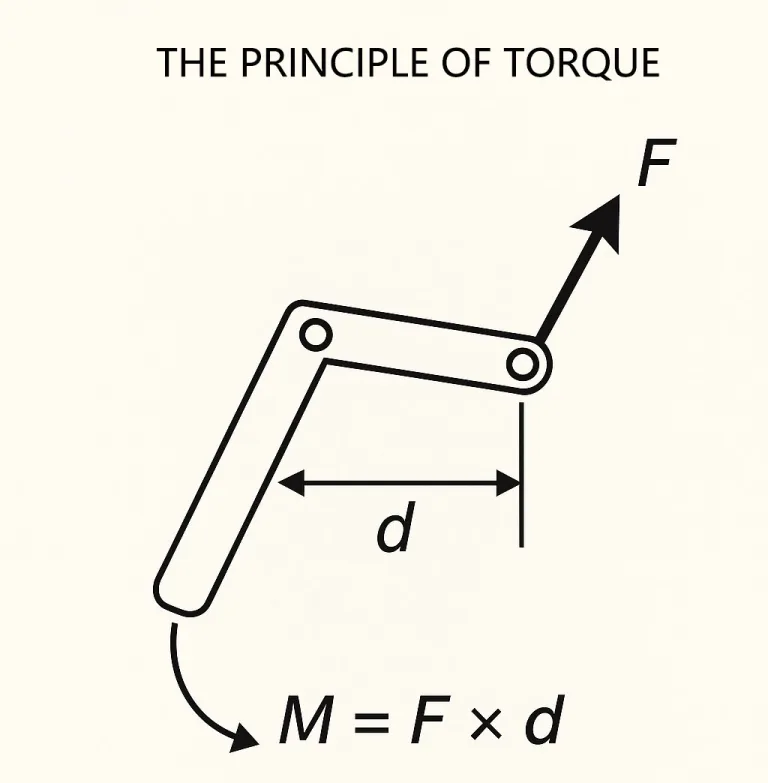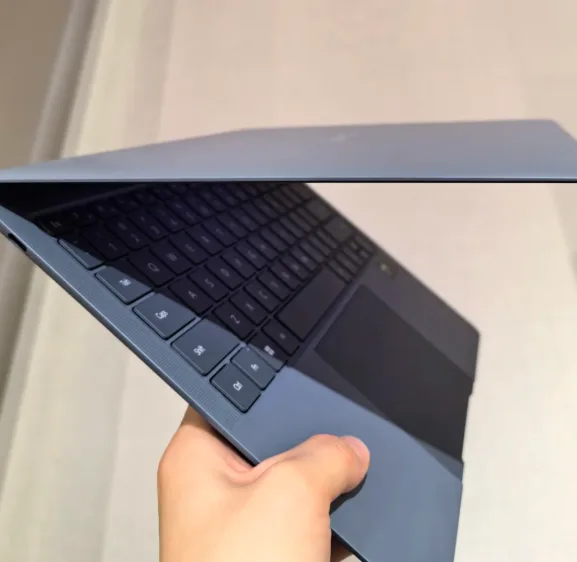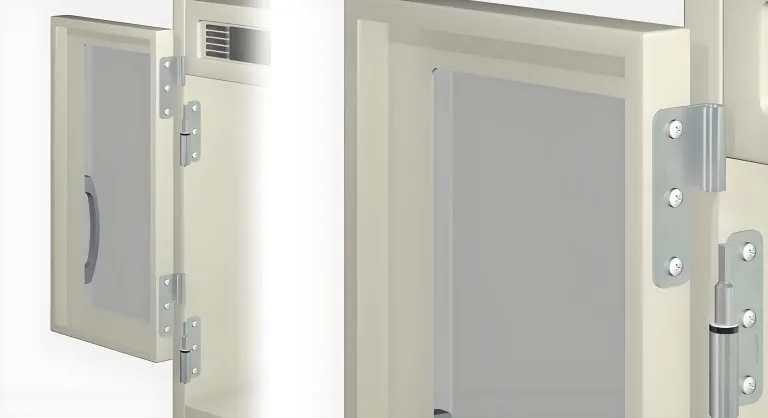Charnières à couple réglable : Principes, structure et applications
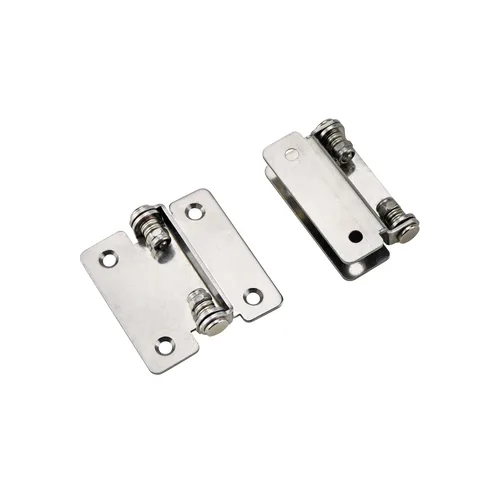
In engineering design, how do you make a heavy lid or display stay put at any angle (Position Control), without “slowly drooping” over time?
Traditional gas spring solutions are complex and prone to failure. The real solution is the Adjustable Torque Hinge—a component that provides constant holding resistance using only internal “controlled friction” for precise positioning.
But how do engineers avoid the single most common design failure: torque miscalculation?
This definitive guide provides the ultimate answer, from core physics and reliability standards (like 25,000-cycle testing) to precise calculation.
What is an Adjustable Torque Hinge?
Precise Definition of Adjustable Torque Hinge
Core Definition:
An Adjustable Torque Hinge is a special type of mechanical hinge. Its core function is to provide a constant, predictable resistance throughout the entire rotational movement range of the hinge through an internal integrated “controlled friction” mechanism.
This resistance is called torque.
Key Characteristics:
This constant resistance enables the hinge to achieve a “position control” function.
With this function, users can smoothly move doors, covers, displays, or arms to any desired angle, and after releasing, the object will automatically stay in that position—without requiring any additional locking devices, gas springs, or support rods.
The Meaning of “Adjustable”:
Unlike fixed torque hinges, the “adjustable” feature means that users—typically engineers or on-site technicians—can precisely set or change the friction torque during use through an external adjustment mechanism on the hinge (such as an adjustment screw).
This allows the hinge to match different load weights or compensate for performance degradation after long-term use.
The Value of “Position Control”
The “position control” function is the most core commercial and engineering value of adjustable torque hinges.
Simplify Design and Reduce Costs:
It eliminates the need for auxiliary support components such as gas springs, mechanical lock pins, magnetic catches, or limiters.
Reduce Failure Points:
Cette conception simplifiée permet non seulement de réduire le coût de la nomenclature du produit, mais aussi de minimiser de manière significative les risques potentiels d'incendie. points de défaillance.
Améliorer l'expérience de l'utilisateur :
Il offre aux utilisateurs finaux une expérience tactile haut de gamme, fluide et silencieuse.
Lors du déplacement de lourdes couvertures ou du réglage de moniteurs médicaux, cette sensation d'amortissement contrôlé et souple est un indicateur clé de la qualité du produit.
Core Distinction: Torque Hinge vs. Damping Hinge vs. Spring Hinge
Dans les applications industrielles, ces trois types de charnières fonctionnelles sont souvent les suivants confus. Bien que charnières d'amortissement et les charnières à ressort génèrent également un couple au sens large, leur les mécanismes physiques et objectifs de la demande sont totalement différents.
Charnière à couple réglable (friction) :
Sa résistance est due à frottement statique force, ce qui signifie que son couple de sortie est indépendant de la vitesse angulaire.
Que l'utilisateur déplace le panneau rapidement ou lentement, la résistance (couple) reste constante.
Il s'agit de la base physique pour atteindre "contrôle de position".
Charnière amortissante :
Sa résistance provient de la cisaillement des fluides visqueux (comme l'huile de silicone), de sorte que son couple de sortie est fortement liée à la vitesse angulaire.
Plus le mouvement est rapide, plus la résistance est grande.
Sa fonction principale est "mise en mémoire tampon" ou "soft-close" (fermeture en douceur)comme dans les portes d'armoires, et il ne peut s'arrêter à aucune position intermédiaire.
Charnière à ressort :
Ce type d'appareil stocke et libère énergie potentielle (par exemple, les ressorts de torsion).
Sa fonction première est de "auto-fermeture" ou "auto-ouvert" (comme dans les portes coupe-feu ou les boîtes à bijoux).
C'est le cas pas fournissent une résistance constante.
Key Functional Hinge Performance Comparison Table
| Caractéristique | Charnière à couple réglable | Charnière d'amortissement | Charnière à ressort |
|---|---|---|---|
| Principe de base | Friction statique contrôlée (Friction) | Cisaillement des fluides visqueux (Viscosité) | Énergie potentielle élastique (ressort) |
| Caractéristique de résistance | Couple constant (indépendant de la vitesse) | Speed-Related Torque | Angle-Related Torque |
| Main Function | Contrôle de position | Soft-Close / Buffering | Self-Close/Open |
| Ajustement | Adjustable | Usually Not Adjustable | Usually Not Adjustable |
| Typical Application | Medical Monitors, Industrial Guards, POS Machines | High-End Cabinet Doors, Toilet Seats | Fire Doors, Self-Closing Box Covers |
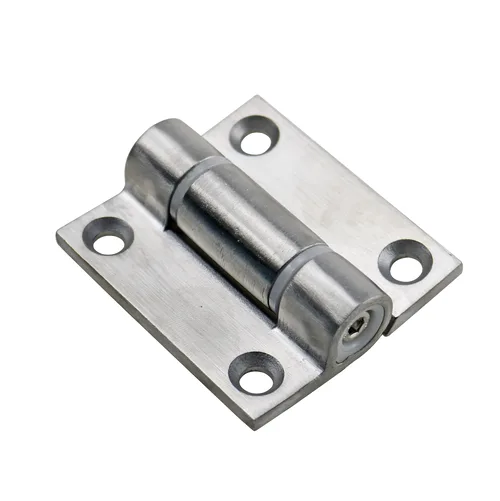
In-Depth Analysis of Working Principle—”Controlled Friction” Physics
Core Physical Model: Source of Torque
The entire secret of adjustable torque hinges lies in the precise control of static friction force.Basic Principle: The rotational torque (τ) of the hinge comes from the friction force (Ff) generated between internal friction plates.Physical Formula: Friction Force Ff = μ × N, where μ is the static friction coefficient between the friction plate materials, and N is the normal force applied to the friction plates.Design Core: The entire hinge’s design goals are two: to maintain the stability of μ value over an extremely long service life (for example, exceeding 25,000 cycles); to provide users with a reliable mechanism to precisely adjust N.
Key Mechanism: Adjustment of “Normal Force”
The “adjustability” of the hinge is essentially the adjustment of “normal force N.”Structural Implementation: The hinge internally usually contains one or more sets of overlapping friction plates (or friction rings).Adjustment Action: When the user tightens the external “adjustment screw,” the screw pushes a pressure plate or a set of Belleville washers.Force Transmission: These springs apply a precise and sustained axial pressure (i.e., “normal force N”) to the entire friction plate stack.Result: The tighter the adjustment screw is tightened, the larger N becomes, leading to an increase in friction force Ff, and ultimately an increase in the hinge’s output torque τ.The use of Belleville washers is the ingenuity of this design. They provide a relatively constant pressure curve. Even if the friction plates undergo minor wear leading to thickness reduction after long-term use (such as after 25,000 cycles), the springs can automatically compensate for this change, thereby keeping the torque within the specification’s ±20% range throughout the entire life cycle.
Constant Torque Characteristic Curve
If a “torque vs. rotation angle” relationship graph of an ideal torque hinge is drawn, its curve feature should basically be a straight line. This means that regardless of whether the cover is at 10°, 45°, or 90°, the holding torque provided by the hinge is constant. This forms a stark contrast with the curves of spring hinges (torque changes with angle) and damping hinges (torque changes with speed).
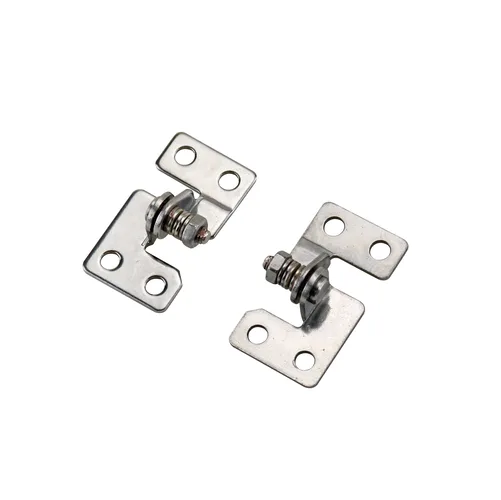
Internal Structure Disassembly and Materials Science
Answer First: Four Core Components
The forms and sizes of adjustable torque hinges vary, but their core structures are all composed of the following four types of key components:Shaft/Pin: Core load-bearing shaft, transmits torque. Must have high shear strength and high surface finish to reduce wear in non-friction areas.Friction Discs: The heart that generates torque. This is the core technology of the hinge, usually appearing in pairs (one fixed on the shaft, one fixed on the housing).Adjustment Mechanism: As described above, the system used to apply and change “normal force N,” usually consisting of an adjustment screw and Belleville washers (or similar spring pieces).Housing: Protects internal components from environmental pollution such as dust and moisture, and provides standardized mounting interfaces (such as screw holes) for fixing to the product.
Materials Science: Balance of Performance and Cost
The material selection of the hinge determines its strength, lifespan, durability, and cost, and must be strictly chosen based on its final application scenario.
Comparison of Common Hinge Materials Performance and Application Scenarios
| Type de matériau | Core Advantages | Main Disadvantages | Typical Application Scenarios | Associated Standards/Performance |
|---|---|---|---|---|
| Stainless Steel (such as SUS304) | Excellent Corrosion Resistance, High Temperature Resistance, High Strength, Easy to Clean and Sterilize | High Cost, High Processing Difficulty | Medical Equipment (Requiring Sterilization), Food Processing Machinery, Outdoor or Marine Environment Equipment | Compliant with IEC 60068-2-78 Damp Heat Test; Cleanroom Compatible |
| Zinc Alloy (such as Zamak) | Low Cost, Easy to Die-Cast into Complex Shapes, Good Electroplating and Coating Adhesion | Strength and Corrosion Resistance Inferior to Stainless Steel, Poor Long-Term Creep | Consumer Electronics Peripherals (POS Machines), Office Furniture, Indoor Cabinet Doors | Cost-Sensitive Applications, Moderate Lifespan Requirements (such as <20,000 Cycles) |
| Engineering Plastics (such as PEEK, PA) | Extremely Light Weight, Self-Lubricating (Low Noise), Chemical Resistance, Electrical Insulation, Non-Magnetic | Lower Load-Bearing Capacity and Rigidity, Sensitive to Temperature Changes | Lightweight Medical Diagnostic Instruments, Aviation Interiors (Weight Reduction), Electronic Equipment Covers, MRI Room Equipment | Miniaturization Trends; Meet Special Environments (such as Non-Magnetic) Needs |

Authoritative Standards and Performance Verification
Answer First: Core Standards for Evaluating Torque Hinges
The “trustworthiness” of a torque hinge does not depend on its promotional copy, but on whether it has passed recognized industry standard tests. In critical applications (such as medical, aviation, heavy industry), hinges lacking standard certification pose huge safety hazards. Professional engineers must request test reports for the following standards from suppliers during selection.
Life Cycle Testing
Key Data: A recognized high-quality benchmark in the industry is >25,000 cycle lifespan.Performance Degradation Indicator: Merely completing 25,000 cycles is not enough. The most critical indicator is that at the end of the life cycle, its dynamic torque must remain within ±20% of the original static torque specification. This ±20% is a key factor that must be considered in design. It means that a hinge with a nominal 10 N・m may only have 8 N・m holding force at the end of life. This directly relates to the “safety margin” calculation in the fifth part—design must compensate for this.Reference Standard Numbers:ANSI/BHMA A156.17: American National Standards Institute (ANSI) issued standard on furniture hardware (including self-closing and free-swinging hinges), its cycle testing method has important reference value.DIN EN 1935: German/EU standard on building hardware (single-axis hinges), although mainly for doors, its defined cycle testing and load testing methods are industry .
Environmental Adaptability Testing
The performance of hinges may change significantly under different temperatures and humidities. The IEC 60068 series standards are the international gold standard for evaluating the reliability of electronic and mechanical components in different environments.Specific Test Items:Cold Test (IEC 60068-2-1): Ensures that the hinge does not fail or jam due to material brittleness (especially plastic parts) or drastic changes in friction plates (μ value) at low temperatures (such as -10°C).Dry Heat Test (IEC 60068-2-2): Ensures that engineering plastic parts do not soften at high temperatures (such as +50°C or higher), and friction torque does not undergo irreversible “thermal degradation.”Damp Heat Test (IEC 60068-2-78): Simulates extreme humid environments (such as 40°C, 90% relative humidity), focusing on testing the rust resistance of stainless steel hinges and whether friction materials fail due to moisture absorption and expansion.
Quick Reference for Key Hinge Technical Standard Numbers
| Standard Number | Standard Name (or Key Content) | Test Purpose |
|---|---|---|
| 3 (Cited Data) | Manufacturer Life Cycle Test | Verify if torque degradation remains within ±20% after >25,000 cycles |
| IEC 60068-2-1 | Environmental Testing Part 2-1: Test A: Cold | Evaluate the impact of low temperature on friction coefficient (μ) and material brittleness |
| IEC 60068-2-2 | Environmental Testing Part 2-2: Test B: Dry Heat | Evaluate the impact of high temperature on friction material performance degradation and creep |
| IEC 60068-2-78 | Environmental Testing Part 2-78: Test Cab: Damp Heat Steady State | Evaluate material’s corrosion resistance and resistance to moisture absorption expansion |
| ANSI/BHMA A156.17 | Hinges (Self Closing and Free Swinging) | North American furniture and hardware industry benchmark for cycle life and load |
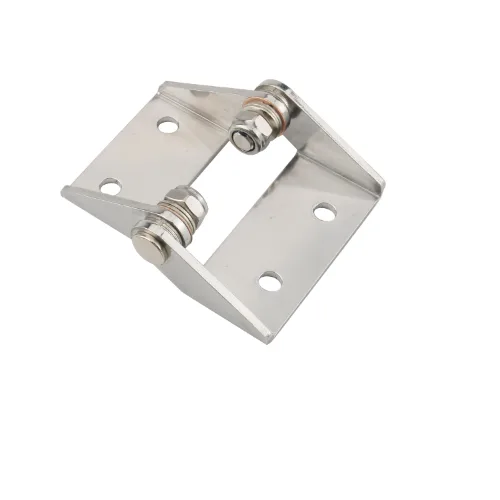
Selection Guide and Precise Torque Calculation
Answer First: Primary Reason for Selection Failure
The most common reason for hinge selection failure is torque calculation error. This usually manifests as:Underestimating the actual torque demand: Leading to the hinge being unable to “position control” in the horizontal position, and the cover slowly sagging.Ignoring the real position of the center of gravity (CoG): Blindly dividing the cover length by 2, leading to calculation deviation.
Authoritative Formulas for Torque Calculation (Three-Tier Evolution)
Multiple sources provide torque calculation formulas, with varying accuracy.
First Tier (Estimation Formula):
Applicable to cases where the cover material is uniform and the center of gravity is exactly at the geometric center. Torque (T, unit N\cdotpm)=Cover Weight (W, unit kg)×9.8 (g)×Cover Length (L, unit m)2\text{Torque (T, unit N·m)} = \text{Cover Weight (W, unit kg)} \times 9.8 \, (\text{g}) \times \frac{\text{Cover Length (L, unit m)}}{2}Torque (T, unit N\cdotpm)=Cover Weight (W, unit kg)×9.8(g)×2Cover Length (L, unit m)
This corresponds to the “Door Height × 1/2 × Door Weight” and “L / 2 × W × 9.8” algorithms.
Second Tier (Precise Formula) (Recommended):
Applicable when the center of gravity is not at the geometric center (such as covers with installed displays or handles). Torque (T, unit N\cdotpm)=Cover Weight (W, unit kg)×9.8 (g)×Horizontal Distance from Center of Gravity to Pivot (X1, unit m)\text{Torque (T, unit N·m)} = \text{Cover Weight (W, unit kg)} \times 9.8 \, (\text{g}) \times \text{Horizontal Distance from Center of Gravity to Pivot (X1, unit m)}Torque (T, unit N\cdotpm)=Cover Weight (W, unit kg)×9.8(g)×Horizontal Distance from Center of Gravity to Pivot (X1, unit m)
This corresponds to the “Horizontal Distance X1 from Rotation Center to Center of Gravity Position × Weight m” algorithm.
Third Tier (Dynamic Formula):
Applicable to applications needing to analyze torque changes throughout the entire motion process of the cover. T(θ)=W×g×Lcog×cos(θ)T(\theta) = W \times g \times L_\text{cog} \times \cos(\theta)T(θ)=W×g×Lcog×cos(θ)
Where LcogL_\text{cog}Lcog is the straight-line distance from the center of gravity to the pivot, and θ\thetaθ is the angle between the cover and the horizontal plane.
This formula indicates that when the cover is in the horizontal position (θ=0∘\theta = 0^\circθ=0∘), cos(0∘)=1\cos(0^\circ) = 1cos(0∘)=1, and the required torque is maximum. Therefore, hinge selection must be based on this maximum torque.
Example Calculation
Given: Cover Length (L) = 0.5 m; Cover Weight (W) = 3 kg. Assume: Cover is uniform, center of gravity at center (L/2 = 0.25 m).Calculate Maximum Torque T:T = W × g × (L / 2)T = 3 kg × 9.8 m/s² × 0.25 mT = 7.35 N·m
Key Consideration: Why Must a 30% Safety Margin Be Added?
After calculating 7.35 N·m above, absolutely do not choose a hinge with a torque upper limit of 8 N·m. Industry best practice recommends adding at least a 30% safety margin. Selection Torque = 7.35 N·m × 1.3 = 9.55 N·m. Engineers should choose a hinge whose adjustable range can easily cover 9.55 N·m (for example, a 5-12 N·m model).This 30% safety margin is used to compensate for:Life Degradation: Cover the ±20% performance degradation mentioned in the standard.Center of Gravity Estimation Error: Compensate for uncertainty in CoG measurement.Dynamic Load: Compensate for additional load from user quickly closing the cover (impact force) or placing extra items on the cover (such as coffee cups).
Cross-Domain Application Scenario Case Analysis
Adjustable torque hinges, with their “position control” and “adjustable” characteristics, solve key engineering challenges in multiple fields.
Industrial Application
Case: Heavy control cabinet doors, machine safety guards, inspection panels on automated production lines.Solve Problems:Safety: Prevent heavy guards or cabinet doors weighing tens of kilograms from suddenly closing, causing crush injuries to operators’ arms (compliant with OSHA and other industrial safety regulations).Convenience: In narrow factory environments, allow maintenance doors to stay at any opening angle (such as 45°), facilitating maintenance without operators holding the door with hands or body.
Équipement médical
Case: Bedside monitor arms, diagnostic equipment (such as ultrasound) displays, operating room shadowless lamp positioning arms, dental treatment chairs.Solve Problems:Quiet and Smooth: Provide a noise-free, vibration-free adjustment experience, avoiding disturbing resting patients.One-Hand Operation: Medical staff can easily adjust the screen position with one hand and make it “position control,” while the other hand can continue operating equipment or caring for patients.Cleanliness: Sealed stainless steel design (refer to Section 3.2) is easy to disinfect and sterilize, compliant with medical environment requirements.
Commercial & Electronics
Case: POS terminal (cash register) displays, high-end laptop stands, portable instrument cases, AR/VR head-mounted displays.Solve Problems:User Haptics: Provide high-end, solid, smooth “damping feel.” This tactile feedback is the direct source for users perceiving whether the product is “high-end.”High-Frequency Durability: Meet the demands of thousands of daily flips for POS machine screens (refer to 25,000 cycle lifespan standard).
Transportation
Case: Airplane first-class or business-class tray tables, in-flight entertainment system (IFE) screens, special vehicles (such as RVs, ambulances) center console storage boxes, yacht covers.Solve Problems:Vibration Resistance: This is the core advantage in transportation vehicles. In continuous vibration environments of airplanes, trains, or vehicles, the constant static friction force ensures that tray tables or screens do not move or sag on their own, ensuring passenger experience and safety.
Installation, Adjustment, and Maintenance Practical Guide
Installation Key: Why is “Axis Alignment” the Primary Step?
90% of early failures of torque hinges (rapid torque decline, jamming, abnormal noise) are caused by improper installation, with the most fatal being “axis misalignment.”
Failure Physics: When using two or more hinges on the same cover, their rotation axes must be strictly parallel.
Consequences: If the axes of two hinges are misaligned (even with slight deviation), the hinges will not only bear torsional loads during rotation but also huge lateral (radial) loads, producing “binding” stress.
Result: This “binding” will greatly increase abnormal wear between friction plates, leading to rapid changes in friction coefficient (μ) or destruction of friction plate surfaces, immediately invalidating the 25,000 cycle lifespan promise.
Torque Adjustment Method (Step-by-Step Guide)
Preparation: Fully install the cover onto the hinge. Use a high-precision torque wrench or spring scale (with lever arm) to measure the current holding torque of the cover in the horizontal position.
Positioning: Find the adjustment screw on the hinge (usually hex or Phillips screw).
Adjustment (Key): Adjust in extremely small increments (such as 1/8 turn or 1/4 turn). Clockwise usually increases torque (increases normal force N), counterclockwise decreases.
Balance (Key): If using two hinges, must ensure the torque settings of both hinges are completely consistent. Alternate adjusting the two hinges until they evenly share the load, otherwise uneven load will again lead to “binding” effect.
Verification: Re-measure the torque, and move the cover throughout the entire motion range (such as 0-90°), ensuring it can smoothly stop at all angles.
FAQ
Q : Why does the hinge torque decline too quickly after a period of use?
A : 1. Axis misalignment leading to abnormal wear (most common reason); 2. Selection error, actual load (including safety margin) far exceeds the hinge’s rated torque, leading to premature crushing of friction plates; 3. Exceeded its design lifespan.
Q : Why does the hinge produce abnormal noise or jamming?
A : 1. Axis misalignment (most common reason); 2. Dust, liquids, or debris entering the hinge interior, contaminating the friction plates; 3. Internal spring or pressure mechanism failure.
Q : Why can’t it be adjusted to the required torque?
A : 1. Wrong torque range in selection (for example, needs 10 N·m, but purchased 2-8 N·m model); 2. (Adjustable hinge) Has reached the limit of the adjustment screw (tightened too tight or too loose).
Conclusion: The Two Keys to Hinge Success
Ultimately, adjustable torque hinges simplify design by providing reliable “stay-put” positioning. Your success hinges on avoiding the single most common failure: torque miscalculation.
To ensure your design works flawlessly over its 25,000-cycle life, focus on two critical actions:
- Calculate with a Safety Margin: Always calculate torque based on the true center of gravity (CoG), not just the panel’s halfway point. Then, add a 30% safety margin. This is not optional; it is essential to compensate for lifetime wear and dynamic loads.
- Ensure Axis Alignment: Improper installation is the number one cause of early failure. The hinge axes doit be perfectly parallel. Any misalignment will create “binding,” rapidly destroying the hinge’s internal components.
Master the calculation and the installation, and you will deliver a robust, reliable product.



